Pelargonium peltatum
Pelargonium peltatum (L) L'Hér.
Family: Geraniaceae
Common names: ivy-leaved pelargonium, ivy pelargonium, wild sorrel, cascading pelargonium (Eng.); kolsuring, wildemalva (Afr.); umnewana, ityholo (isiXhosa)
Introduction
The ivy-leaved pelargonium is a winner and a beautiful garden plant.
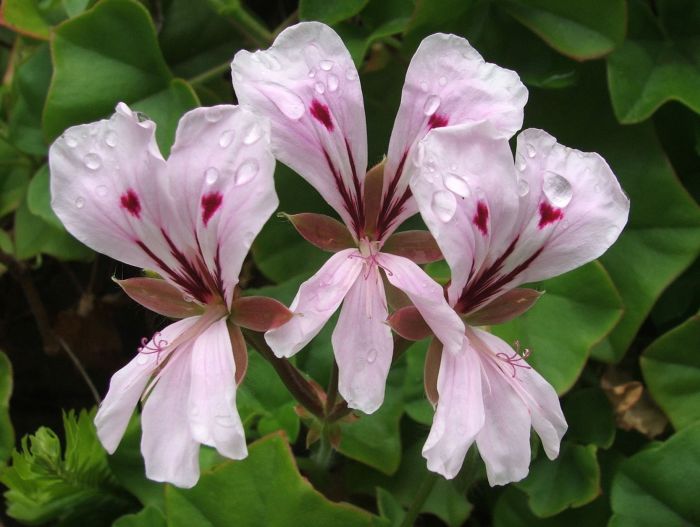
Description
Description
Pelargonium peltatum is a climbing, semi-succulent perennial, trailing through other trees and shrubs in its habitat. It has long, straggling shoots, which can reach a height of 2 m. This plant is characterized by its ivy-shaped leaves. Some of the leaves have distinctive zonal markings, but this is not a common characteristic. It produces clusters of flowers varying from mauve or pinkish mauve to pale pink or white. It flowers mainly in spring and early summer, from September to December.
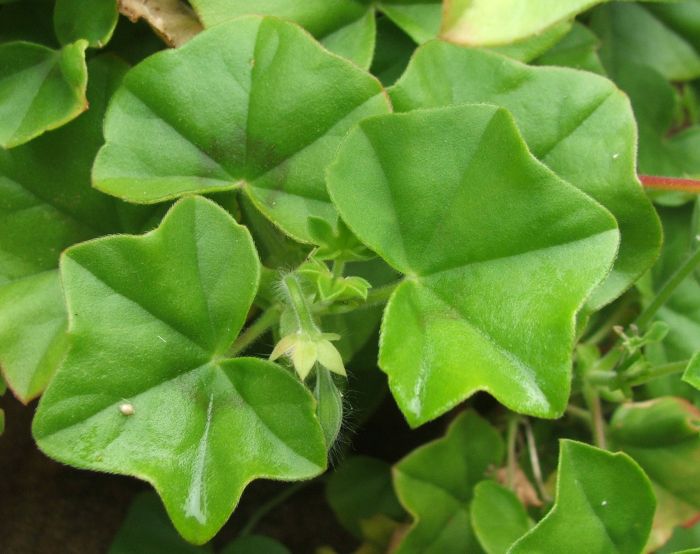
Conservation Status
Status
Least Concern (LC). Pelargonium peltatum is not threatened.
Distribution and habitat
Distribution description
Pelargonium peltatum grows along coastal and succulent scrub from Bainskloof to East London.
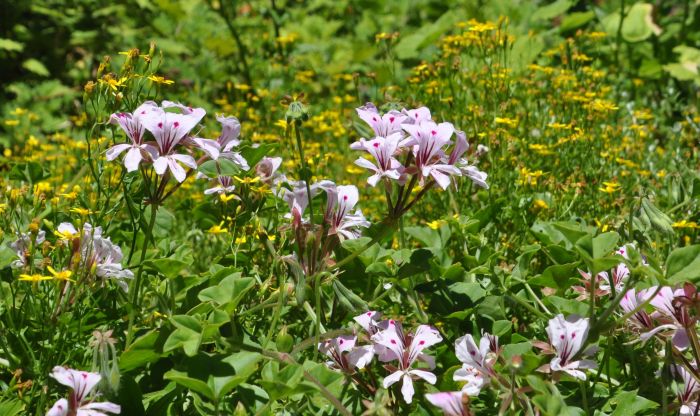
Derivation of name and historical aspects
History
The genus Pelargonium belongs in the Geraniaceae, a large family of 11 genera and 800 species in the subtropical and tropical areas of the world. There are about 270 species of Pelargonium, which occur in S, E and NE Africa, Asia, St Helena, Tristan da Cunha, Madagascar, Australia and New Zealand ; of this amount, 219 species occur in southern Africa.
The genus Pelargonium derives its name from the resemblance of the shape of the fruit to the beak of a stork, pelargos in Greek. The species name peltatum meaning 'sheild-like' or peltate (Latin) refers to the shape of the leaves, the petiole being attached to the centre of the blade. The Afrikaans common name kolsuring (meaning blotch sorrel) refers to the acidulous sap the leaves contain and the spots of colour on the two top petals. The English common name, ivy-leaved, refers to its resemblance to ivy.
Pelargonium peltatum, from which many hybrids have been derived, was introduced into the Netherlands by Willem Adriaan van der Stel in 1700. Sir Frances Masson introduced the species in to Great Britain in 1774.
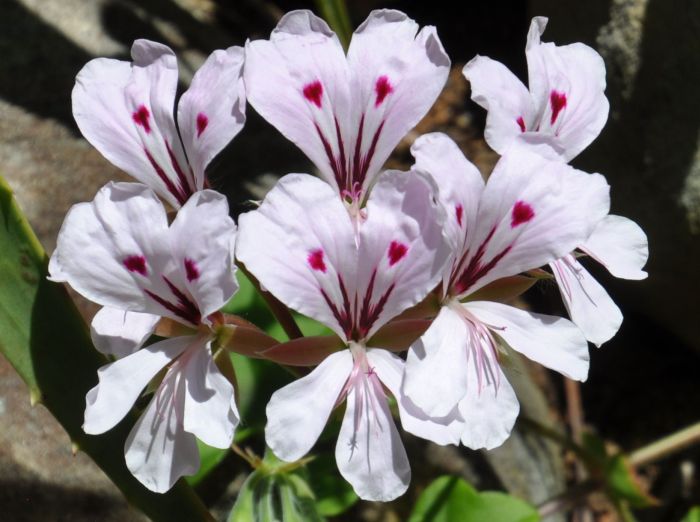
Ecology
Ecology
According to Pitte Joffe (2001), larvae of the Water Bronze, Common Geranium Bronze and Dickson's Geranium Bronze butterflies feed on geraniums and pelargoniums. Carpenter bees are also frequent visitors to the plants.
Uses
Use
The sour-tasting sap of the ivy-leaved pelargonium is used traditionally to treat sore throats.The buds and young leaves can be eaten and are thirst quenching. The leaves can be pounded and used as an antiseptic for scratches, wounds, grazes and minor burns. The petals are astringent, and can be used to make a wash for greasy skin. The petals can also be used to make a beautiful, long-lasting, grey-blue dye that can be used for painting or to dye wool or cloth.
The plants have been used extensively in horticulture and thousands are grown each year for window boxes and other applications.
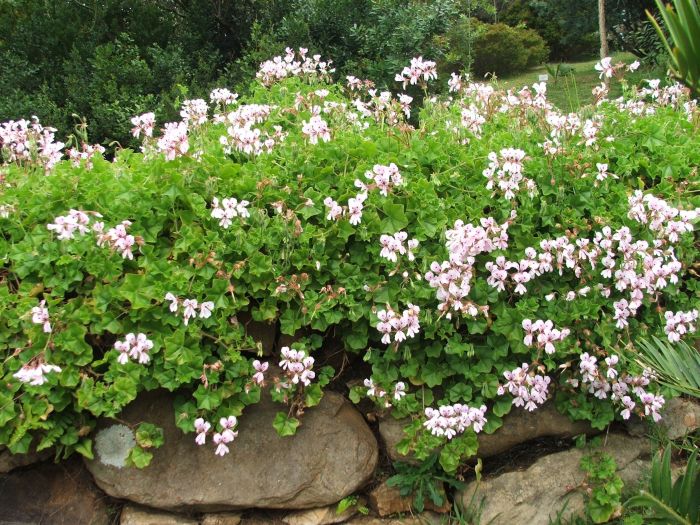
Growing Pelargonium peltatum
Grow
Propagation of Pelargonium peltatum is very easy. The plant can either be grown by cuttings or seed.
Cuttings can be taken in spring and autumn or after the flowering or seeding period. Semi-mature stem cuttings can be taken from young healthy growth. The rooting hormone for softwood or semi-mature wood is used to help with the rooting process. The cuttings are placed in a propagation tray and placed in a cold frame to root. Rooting of this species takes place within 4 weeks. Once they are well rooted they can then be potted in a well-drained soil mix.
Seed can be sown in a well-drained soil mix. Seed should be sown to a depth of 2-3 mm in late autumn. Germination should occur 3-4 weeks after sowing.
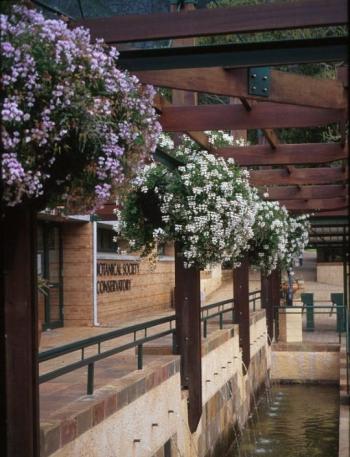
Both the cuttings and seedlings should be fed with an organic-based fertilizer. Fungal infections may occur during and after periods of damp or wet weather. Spray with an appropriate fungicide if there are any signs of mildew or rust. Tiny caterpillars eat out the centre of the flower buds and appropriate measures should be taken to control themThis plant can be used in many ways. Plant it alongside trees or a trellis, encouraging it to scramble up. Or plant it to cascade down terraced or retaining walls. It is also excellent as a container plant for hanging baskets, window boxes and planter troughs. The plant does well in shade and full sun, although it flowers more profusely in full sun. It also makes an excellent groundcover under larger trees. . Dead flowers must be pinched off to promote more flowering and maintain a neat and tidy plant. In autumn, long and leggy stems should be cut back to the point where healthy green leaves remain on the plant. This pruning will allow your plant to grow and flower profusely.
References
- Nichols, G. 2005. In the ivy league: the indigenous garden. Farmer's Weekly, 28 Jan.: 78, 79.
- Joffe, P. 2001. Creative gardening with indigenous plants. Briza Publications, Pretoria.
- Joffe, P. 1993. The gardener’s guide to South African plants. Tafelberg Publishers, Cape Town.
- Manning, J. 2001. Eastern Cape. South African Wild Flower Guide 2. Botanical Society of South Africa , Cape Town.
- Roberts, M. 1990. Indigenous healing plants. Southern Book Publishers, Halfway House, Johannesburg.
- Schofield, G. 2005. Pelargonium peltatum hybrids. The Gardener, Aug.: 72.
- Van der Walt, J J A. 1977. Pelargoniums of South Africa. Purnell, Cape Town.
Credits
Trevor Adams
Kirstenbosch National Botanical Garden
October 2005
Photos by Alice Notten, Kirstenbosch National Botanical Garden
Updated November 2019
Plant Attributes:
Plant Type: Ground Cover, Scrambler
SA Distribution: Eastern Cape, Western Cape
Soil type: Sandy, Loam
Flowering season: Spring, Early Summer
PH: Acid, Neutral
Flower colour: White, Pink, Mauve/Lilac
Aspect: Full Sun, Morning Sun (Semi Shade), Afternoon Sun (Semi Shade)
Gardening skill: Easy
Special Features:
Horticultural zones










Rate this article
Article well written and informative
Rate this plant
Is this an interesting plant?
Login to add your Comment
Back to topNot registered yet? Click here to register.